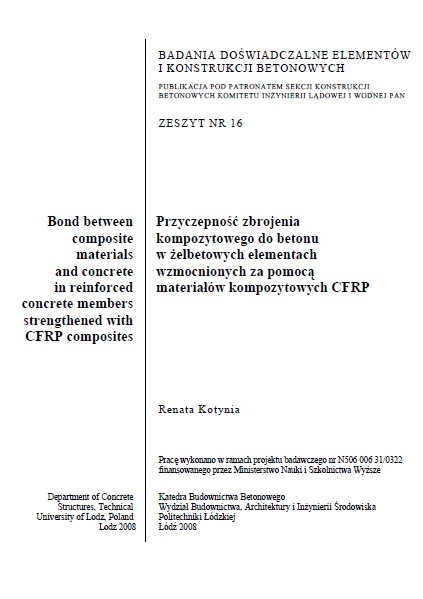Abstract
The research project concerns the problem of adherence of composite carbon fibre materials to concrete. The test model suggested by RILEM (the tests of steel reinforcement bonding to concrete, 1982) has been adopted to the bond test of composite materials to concrete.
The test included 50 concrete reinforced beams unstrengthened and strengthened with carbon fibre composite materials. The beams were divided into two basic Series distinguished by a kind of composite reinforcement (E and N).
In E Series, the beams were strengthened with strips and sheets bonded on the tension surface of the elements, in series N, the strips were bonded into grooves made in the concrete cover of the beams. In each of the basic series (E, N) the low beams of type I, tall beams of type II, long beams of type L, and short beams of type S were distinguished. Two different tapes of the steel reinforcement were adopted: type A – beams reinforced with 2#8mm, and type B – beams reinforced with 2#16mm. In N Series beams, reinforced with NSM strips, three bond lengths were assumed: 80mm, 120mm, 160mm. In both Series (E, N), two classes of concrete of compressive strength 20MPa and 40MPa were adopted. In order to test the influence of the longitudinal steel reinforcement on the bond conditions of the composite material to concrete, the steel bars in four beams were cut through.
The test results indicated that the increase in concrete strength delayed the debonding of the strips and increased the ultimate strain of the composite at its debonding. Due to the mode of failure of the beams under bending the concrete strength had an insignificant influence on the load bearing capacity of the tested elements, both in the case of beams strengthened with the NSM strips, and in the case of the beams externally strengthened with sheets and strips.
The measurements of the composite strain along the bond length proved the influence of the position of the tested section on the composite strain. If the section was situated within the pure bending zone, the debonding occurred later (with higher ultimate strains of the strips) than in the case of the position of the tested section within the zone of the simultaneous action of the moment and the shear force.
Beams reinforced with rigid strips externally bonded on the surface of concrete demonstrated higher bond stress, compared to the beams strengthened with flexible sheets. The influence of the steel reinforcement on bond behaviour between the strips and concrete was confirmed, and cutting through the reinforcement delayed the debonding of the strips, and thus made a significant increase in their ultimate strain.
References
Kotynia R., Kamińska M. E.: „Odkształcalność i sposób zniszczenia żelbetowych belek wzmocnionych na zginanie materiałami kompozytowymi CFRP”, Zeszyt 13, Wyd. Katedry Budownictwa Betonowego PŁ, Łódź, 2003.
Kotynia R.: “Analysis of reinforced concrete beams strengthened with near surface mounted FRP reinforcement”. Archives of Civil Engineering, LII 2,September 2006, pp. 305-317.
Barros, J.A.O., Fortes, A.S.: “Flexural strengthening of concrete beams with CFRP laminates bonded into slits”, Journal of Cement & Concrete Composites, Vol. 27, 2005, pp. 471-480.
De Lorenzis, L. and Teng, J., “Near-Surface Mounted FRP Reinforcement: An Emerging Technique for Strengthening Structures”, Composites Part B: Eng., 38, 2, 2007, pp. 119-143.
Hassan, T. and Rizkalla, S., “Investigation of Bond in Concrete Structures Strengthened with Near Surface Mounted Carbon Fiber Reinforced Polymer Strips”, Journal of. Composites for Construction., 7, 3, 2003, pp. 248-257.
Täljsten, B., Carolin, A., and Nordin, H., “Concrete structures strengthened with near surface mounted reinforcement of CFRP”, Advanced. Structural Engineering, 6, 3, 2003, pp. 201–213.
Blaschko M., “Zum tragverhalten von betonbauteilen mit in schlitze eingeklebten CFK-lamellen”. Bericht 8/2001 aus dem Konstruktiven Ingenieurbau, TU Mnchen, 2001, 147 pp.
Seracino, R., Jones, M.N., Ali, M.S.M., Oehlers, J.D., “Bond strength of near-surface mounted FRP Strip-to-concrete joints”, Journal of. Composites for Construction, 11, 4, 2007, pp. 401-409.
Yao, J., Teng, J. G., and Chen, J. F. 2005a.: “Experimental study on FRP-to-concrete bonded joints”, Composites Part B: Eng ., 36, pp. 99–113.
Maeda T, Asano Y, Ueda T, Kakuta Y.: “A study on bond mechanism of carbon fiber sheet. Non-metallic (FRP) reinforcement for concrete structures”, Proceedings of 3rd Int. Symposium, Sapporo, Japan 1997, pp. 287–95.
De Lorenzis, L., Nanni, A.: “A Bond Between Near-Surface Mounted FRP Rods and Concrete in Structural Strengthening”, ACI Structural Journal, V. 99, No.2, 2001, pp. 123-132.
Sena-Cruz, J. M. S., Barros, J. A. O., “Bond Between Near Surface Mounted Carbon-fiber-reinforced Polymer Laminate Strips and Concrete”, Journal of. Composites for Construction, 8, 6, 2004, pp. 519–527.
RILEM, “Bond test for reinforcement steel. 1. Beam test”, TC9-RC, 1982.

